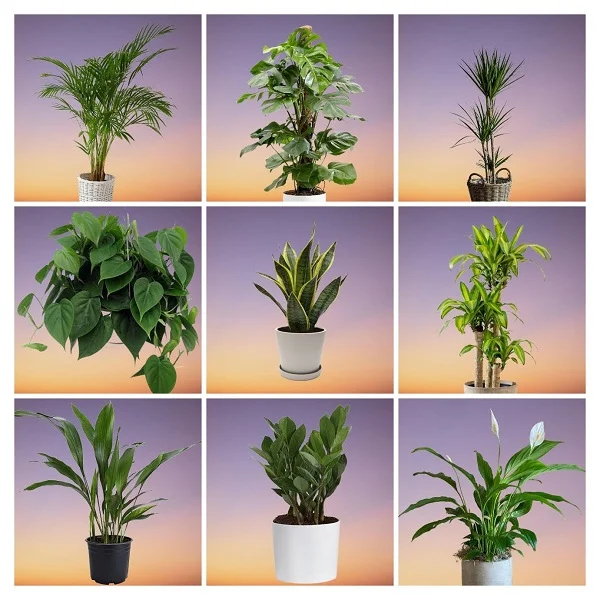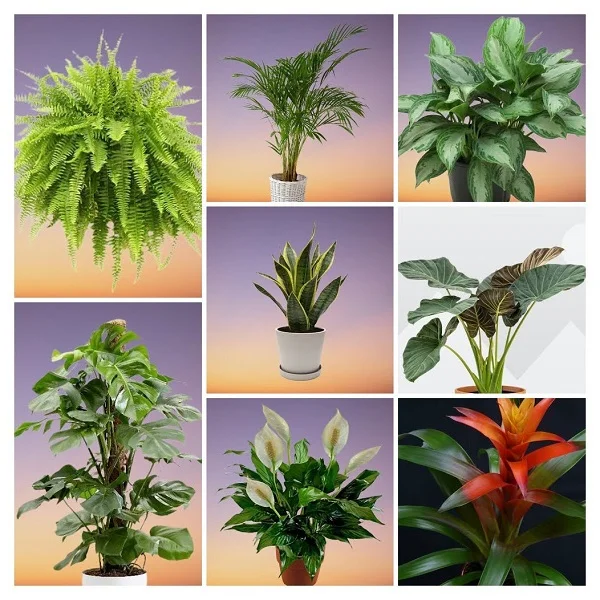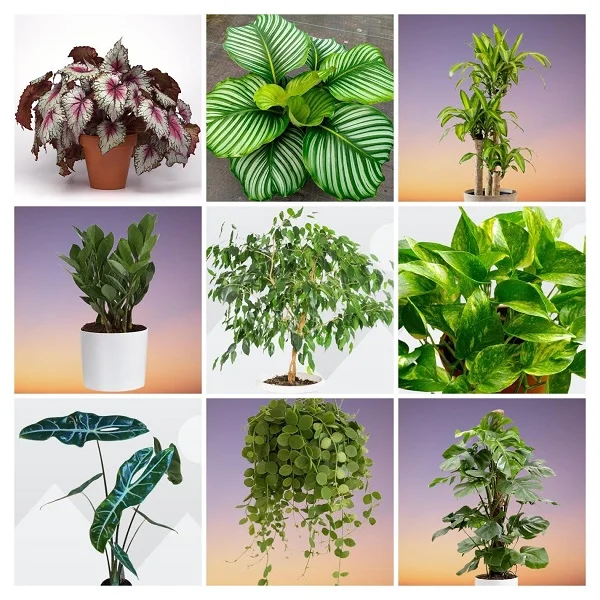30 Sun Loving Indoor Plants That Thrive in Direct Sunlight: Sun-tolerant Houseplants
Some links in this post may be affiliate links
Sun-loving indoor plants have their origin in the warm tropical climates where they get exposed to direct sunlight for part or for the whole day.
Houseplants that thrive with some direct sunshine require high amounts of light for photosynthesis (food making), growth and in some cases to promote flowering.
The Cacti, most succulents and most flowering plants need very bright light and some some direct sunlight for part of the day to thrive when grown indoors.

The sun-tolerant houseplants can be grown under direct sunlight but they require to be acclimated gradually before exposing them to direct sunlight to avoid scorching.
However, where the sunlight is very hot, these plants should be protected from hot direct sunshine to prevent loss of leaf color and sun scorch.
Are you looking for sun-tolerant plants? We have herebelow outlined for you 30 plants that will thrive under direct sunshine to make it easier for you to make your choice.
30 Houseplants That Thrive in Direct Sunlight
The best sun-loving plants are Panda Plant, Bush Lily, Bird of Paradise Plant, Bengal Fig, Bougainvillea Plant, Chinese Hibiscus, Burro's Tail Plant, Snake Plant, String of Dolphins Plant among others.
1. Panda Plant (Kalanchoe tomentosa)
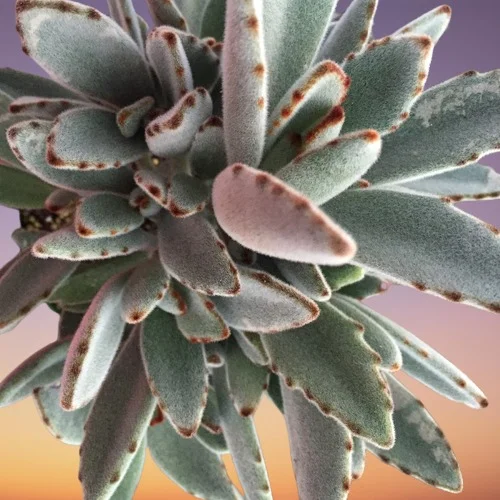
Panda Plant also called Pussy Ears Kalanchoe or Chocolate Soldier is one of the popular Kalanchoe varieties with silvery-green, brown-edged, furry or woolly leaves and hence its other common names.
Pussy Ears Kalanchoe and its relatives Kalanchoe blossfeldiana (Flaming Katy), Kalanchoe daigremontiana (Devil's Backbone Kalanchoe) and Kalanchoe uniflora (Trailing Kalanchoe) require to be exposed to direct sunshine to thrive.
Kalanchoe tomentosa prospers in bright light to full sunlight, warmth of 16-260C, humidity of 50-55% and moderately moist, fertile, well-drained succulents potting mix coupled monthly feeding during the growing season.
Learn more on how to grow and care for Panda Plant
2. Bird of Paradise Plant (Strelitzia reginae)
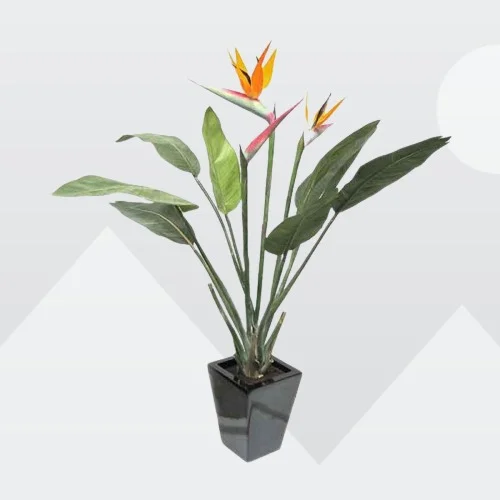
Bird of Paradise Plant or Crane Flower is a spectacular flowering plant with vivid bright orange and blue flowers borne on top of tall stalks and surrounded by large leaves.
Crane Flower Plant and its relatives Strelitzia nicolai (White Bird of Paradise Plant) and Ravenala madagascariensis (Traveller's Palm) are large-leafed plants which will make a bold statement in any space.
Strelitzia reginae grows best in bright light with 4-6 hours of direct sunshine, warmth of 13-270C, humidity of 60-70% and consistently moist, fertile, well-drained potting soil coupled with monthly feeding during the growing season.
Read more on how to grow and care for Bird of Paradise Plant
3. Bengal Fig (Ficus benghalensis 'Audrey')

Ficus benghalensis 'Audrey' also called Ficus Audrey, Bengal Fig, Banyan Fig, Banyan Tree, Indian Banyan or Strangler Fig is one of the popular Ficus varieties and bears green, oval leaves with a fuzzy surface and a smooth light-colored trunk.
Banyan Fig and its cousins Fiddle Leaf Fig (Ficus lyrata), Variegated Triangle Leaf Fig (Ficus triangularis 'Variegata') and Weeping Fig (Ficus benjamina) are sun-loving tree-like plants perfect for the large spaces in the home or office.
Ficus benghalensis 'Audrey' thrives in bright light with 4-6 hours of morning or late afternoon sunshine, warmth of 16-260C, humidity of 50-55% and moderately moist, rich, well-drained soil coupled with monthly feeding during the growing season.
Learn more on how to grow and care for Bengal Fig
4. Paper Flower (Bougainvillea glabra)
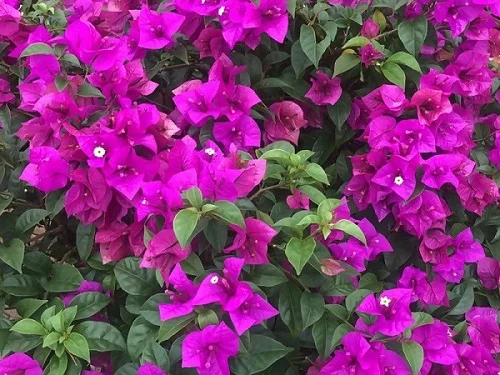
Bougainvillea glabra comes in many hybrids like Mrs Butt with large leaves and large, rose-crimson-flowers, Magnifica which is purple, Raspberry Ice whose flowers are a ravishing red and Alexendra which is pink among others.
Paper Flower like Fuchsia hybrida is a popular flowering plant on account of its showy blooms and can be grown as a shrub, a hanging basket plant, a bonsai or allowed to climb up a trellis.
Bougainvillea glabra blossoms in very bright light with at least 4-6 hours of sunlight, warmth of 16-270C, humidity of 50-55% and moderately moist, fertile, well-drained soil coupled with fortnightly feeding during the growing season.
Learn more on how to grow and care for Paper Flower Plant
5. Bloodleaf Plant (Iresine herbstii)
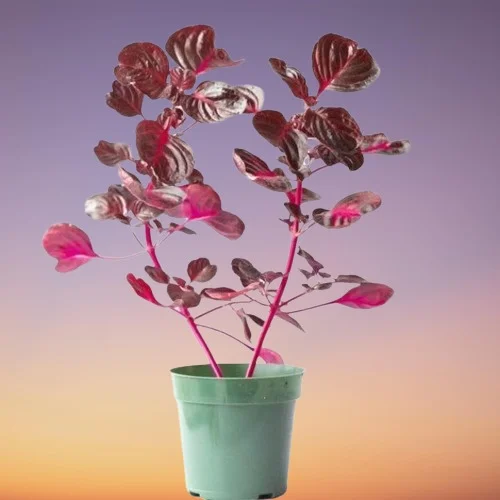
Bloodleaf Plant also called Beef Steak Plant or Red Iresine is an easy-care plant with wine-red stems and rounded or lance-shaped leaves with prominent red veins. The small, greenish-white flowers are inconspicuous.
Red Iresine and Iresine herbstii aureoreticulata (Chicken Gizzard) which bears red stems and green leaves with yellow veins are colorful sun-loving plants for the home.
Iresine herbstii flourishes in very bright light with 4-6 hours of sunlight, warmth of 18-260C, humidity of 55-65% and consistently moist, rich, well-drained potting mix coupled with fortnightly feeding during the growing season.
Learn more on how to grow and care for Bloodleaf Plant
6. Chinese Hibiscus (Hibiscus rosa-sinensis)
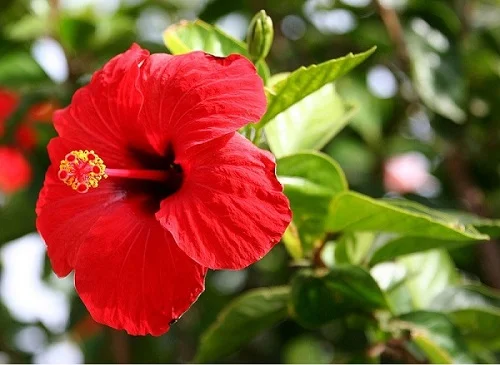
Chinese Hibiscus also called Tropical Hibiscus, Rose of China or Shoeblackplant is a popular flowering indoor plant on account of its large, ruffled, trumpet-shaped blooms which come in many vibrant colors like red, white, yellow , pink, orange, purple, peach and may be single, double or semi-double.
Unlike the cold-hardy Hibiscus, Tropical Hibiscus can only be grown in containers in the colder climates which can be taken inside during winter to shelter them from frost. It is hardy in USDA Zones 10-11 where the temperatures do not go below -10C in winter.
Chinese Hibiscus thrives in bright light with 6-8 hours of direct sunlight, warmth of 16-290C, humidity of 50-55% and consistently moist, fertile, well-drained, slightly acidic potting soil coupled with fortnightly feeding during the growing season.
Read more on how to grow and care for Chinese Hibiscus
7. Burro's Tail Plant (Sedum morganianum)

Burro's Tail Plant or Donkey's Tail Plant is a trailing plant which bears 2-3 feet long stems, completely clothed with blue-green, cylindrical, succulent leaves and is ideal for a hanging basket.
Donkey's Tail Plant like Sedum pachyphyllum (Blue Jelly Beans Plant) thrives in very good light with some sunshine but not extreme heat. They should be kept away or shielded from hot midday sunshine to prevent scorching.
Sedum morganianum grows best in bright light with 6-8 hours of direct sunshine, warmth of 18-260C, humidity of 50-55% and moderately moist, fertile, loose succulents potting soil coupled with monthly feeding during the growing season.
Learn more on grow and care for Burro's Tail Plant
8. Snake Plants (Dracaena trifasciata)
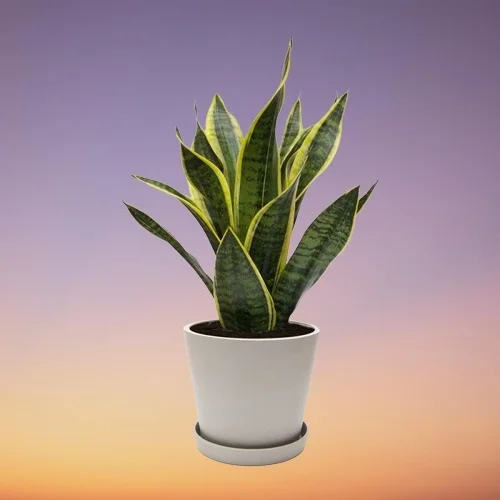
Snake Plants also called Mother in-law's Tongue are popular plants for the home on account of its long beautifully colored foliage and ability to clean indoor air.
There are many varieties of Snake Plants which are favoured for their hardiness as they can withstand low light, dry air, drafts and periods without water but are prone to root-rot in soggy soil.
Dracaena trifasciata flourishes in bright light with 6-8 hours of direct sunlight, warmth of 16-290C, humidity of 50-55% and moderately moist, loose, fertile succulents soil coupled with monthly feeding during the growing season.
Learn more on how to grow and care for Snake Plants
9. Bear's Paw Succulent (Cotyledon tomentosa)
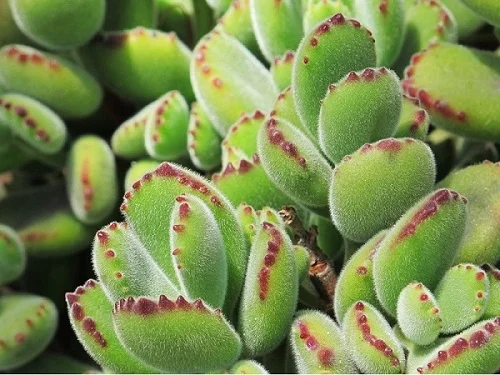
Bear's Paw Succulent also called Bear Claw Succulent or Cat Paw Succulent is an evergreen shrub which bears large, chunky, ovate, fuzzy, light-green leaves with prominent 'teeth' at the tips which turn deep red in bright light and look-like a bears claws and this gives this plant its common name.
Apart from Cotyledon tomentosa, other popular Cotyledons are Cotyledon campanulata (Bell-flowered Cotyledon) with elongated, upright, fleshy, light-green, finger-like leaves covered with fine hairs, Cotyledon pendens (Cliff Cotyledon) with thick stems which are packed with short, fleshy, oval-shaped leaves covered with a powdery grey coat and Cotyledon velutina (Velvet Cotyledon) which bears round, gray-green leaves with reddish margins towards the apex and have a velvety feel.
Cotyledon tomentosa blossoms in bright light with at least 4-6 hours of direct sunlight, warmth of 15-260C, humidity of 50-55% and loose, fast draining soil that is low in organic matter coupled with monthly feeding during the growing season.
Read more on how to grow and care for Bear's Paw Succulent
10. Desert Cacti
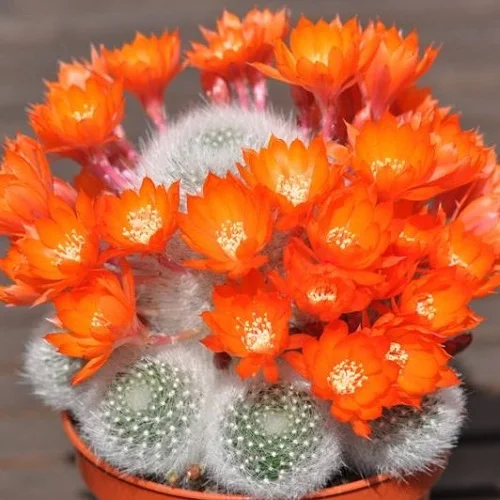
Desert Cacti are some of the popular indoor plants on account of their numerous forms and sizes and their tolerance to some level of neglect.
The native habitat of Desert Cacti is subject to drought; many live in extremely dry environments like the Atacama Desert with very bright sunlight. They are some of the drought-tolerant plants for the home.
Desert Cacti perform best in bright light to full sunlight with at least 2-3 hours of sunshine per day, warmth of 16-280C, humidity of 50-55% and moderately moist, well drained cactus potting soil coupled with monthly feeding during the growing season.
Learn more on how to grow and care for Desert Cacti
11. Bush Lily (Clivia miniata)
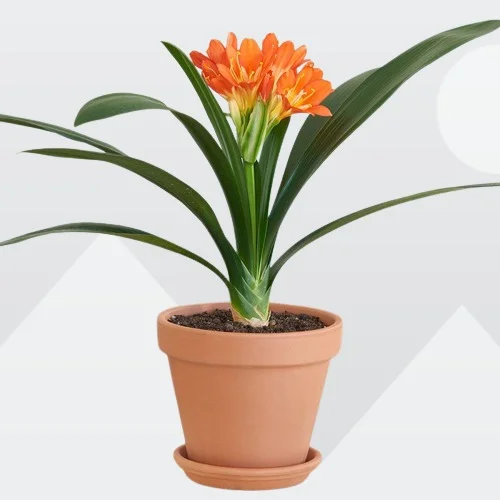
Bush Lily also called Natal Lily is one of the popular flowering plants which bears large clusters of flowers and easily adapts to indoor growing conditions.
Natal Lily grows to a height of 18 inches. On account of its compact size and love for some direct sunshine, Bush Lily is one of the best plants for a sunny balcony and other sunny locations.
Clivia miniata blooms in bright light with 4-6 hours of direct sunlight, warmth of 16-280C , humidity of 50-55% and moderately moist, rich, well-drained soils coupled with fortnightly feeding during the growing season.
Read more on how to grow and care for Bush Lily
12. Geraniums (Pelargonium x hortorum)
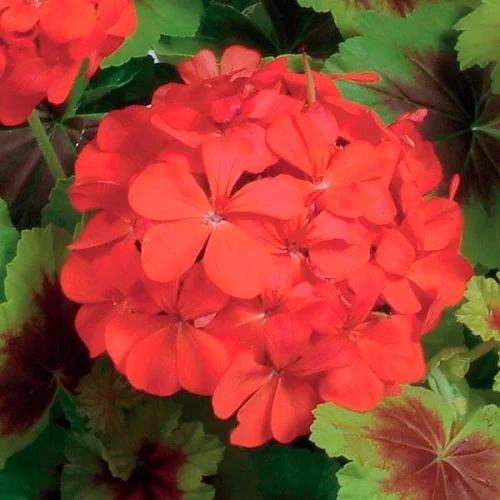
Geraniums are popular flowering plants due to their ease of care, large colourful blooms and a long flowering period where it will bloom almost all year-round if kept on a sunny window at average room temperature.
Pelargonium x hortorum like Pelargonium peltatum are prolific bloomers with magnificent foliage and large, delightful flowers which may be single, semi-double or double.
Pelargonium x hortorum blooms in bright light with 4-6 hours of direct sunlight, warmth of 18-270C, humidity of 50-55% and consistently moist, rich, well-drained potting mix coupled with monthly feeding during the growing season.
Learn more on how to grow and care for Geraniums
13. Wax Begonia (Begonia semperflorens)
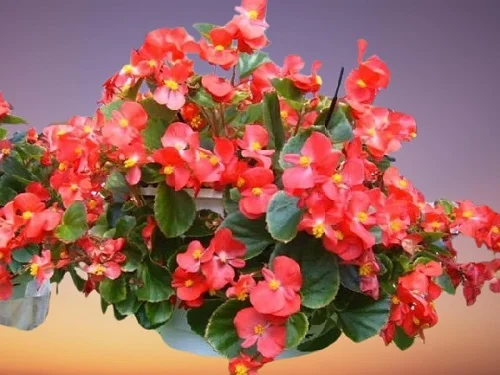
Begonia semperflorens is one of the popular Begonia varieties on account of its vibrant blooms, striking waxy foliage and ability to adapt to a wide range of growing conditions. It is one of the easiest of the flowering Begonias.
It has many hybrids with a wide range of flower types in red, white, orange and pink. Newer hybrids are regularly developed which are more compact and have bigger blooms. On account of its magnificent blooms Wax Begonia like Begonia coccinea (Angel Wing Begonia) is one of the best flowering plants for the home.
Begonia semperflorens thrives bright indirect light with 4-6 hours of direct sunshine,warmth of 18-270C, humidity of 60-70% and moderately moist, rich, well-drained soil coupled with fortnightly feeding during the growing season.
14. Jade Plant (Crassula ovata)
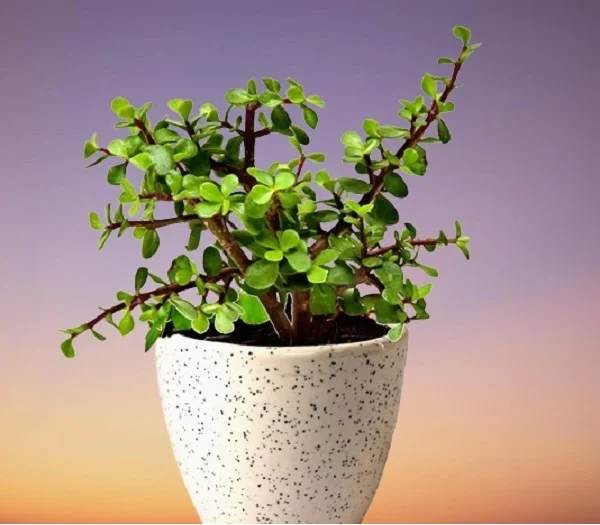
Jade Plant is a popular succulent plant with thick branches and thick, shiny and smooth leaves which grow in opposite pairs along the branch and can withstand a great deal of neglect and mismanagement.
The leaves and stems in Jade Plant and in its cousins Crassula arborescens (Silver Dollar Jade), Crassula falcata (Propeller Plant) and Crassula rupestris (Crassula Baby Necklace) are fleshy and store water which allow these plants to go for a considerably long period without being watered placing these plants among the best drought-tolerant plants.
Crassula ovata blossoms in bright light with 4-6 hours of direct sunlight, warmth of 15-260C , humidity of 50-55% and moderately moist, fertile, well-drained succulents potting soil coupled with monthly feeding in the growing season.
Read more on how to grow and care for Jade Plant
15. String of Dolphins Plant (Senecio peregrinus)
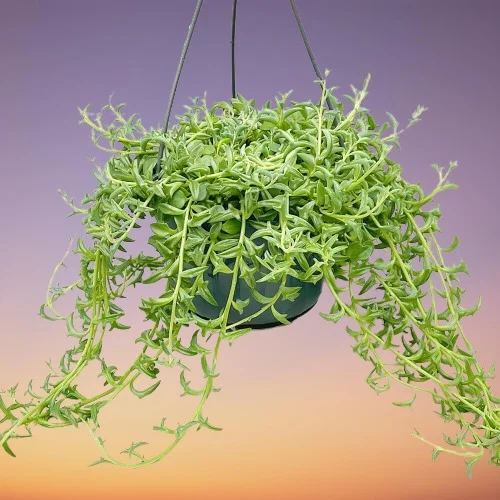
String of Dolphins Plant also called Dolphin Necklace, Flying Dolphins or Dolphin Plant bears pendant thread-like stems on which curvy leaves with two small points grow and look like a pod of flying or jumping dolphins, hence, the common name.
The fleshy leaves in Dolphin Necklace like in String of Pearls Plant (Senecio rowleyanus), String of Bananas Plant (Senecio radicans), String of Watermelons Plant (Senecio herreanus) and String of Lemons Plant (Senecio citriformis) have translucent windows which allow light to reach into the interior of the leaf where photosynthesis takes place.
Senecio peregrinus prefers bright light with 4-6 hours of direct sunlight, warmth of 20-270C, humidity of 50-55% and moderately moist, rich, well-drained succulents potting mix coupled with monthly feeding in the growing season.
Learn more on how to grow and care for String of Dolphins Plant
16. Haworthia Plants
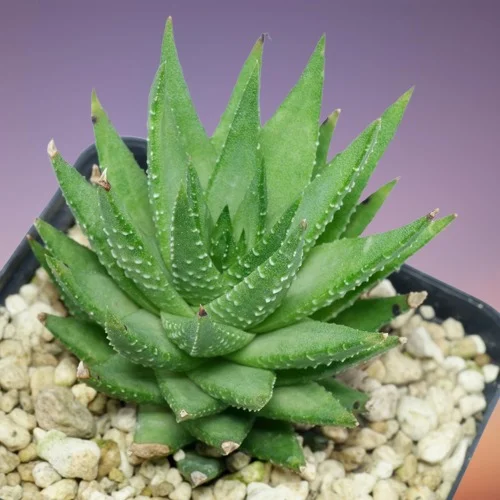
Haworthia Plants have firm, tough, fleshy leaves, usually dark-green in color while others are softer and contain leaf windows with translucent panels through which sunlight can reach internal photosynthetic tissues.
Popular Haworthias include Haworthia attenuata, Haworthia pumila, Haworthia papillosa, Haworthia fasciata, Haworthia reinwardtii, Haworthia cooperi among others. Check out these 14 Haworthia succulents for the home.
Haworthia flourish in bright light with 6-8 hours of direct sunlight, warmth of 18-260C, humidity of 50-55% and slightly moist, fertile, well-drained succulents soil coupled with monthly feeding during the growing season.
Learn more on how to grow and care for Haworthia Plants
17. Tree Houseleeks (Aeoniums)
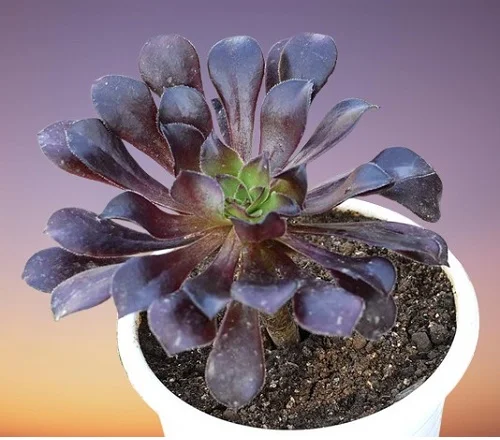
Aeoniums commonly called Tree Houseleeks bear succulent, glossy, spoon-shaped leaves which are typically arranged on a basal stem in a dense spreading rosette and can be low-growing plants or can be large trees.
Tree Houseleeks can be low-growing plants like Aeonium tabuliforme (Flat-topped Aeonium or Saucer Plant) or can be large trees like Aeonium arboreum (Tree Aeonium) which can grow to a height of 6-8 feet. Here are 18 Aeonium plants varieties for growing in the home.
Aeoniums grow best in bright light with at least 4-6 hours of direct sunlight, warmth of 18-240C, humidity of 50-55% and moderately moist, fertile succulents potting soil coupled with monthly feeding in the growing season.
Learn more on how to grow and care for Tree Houseleeks
18. Spineless Yucca (Yucca gigantea)
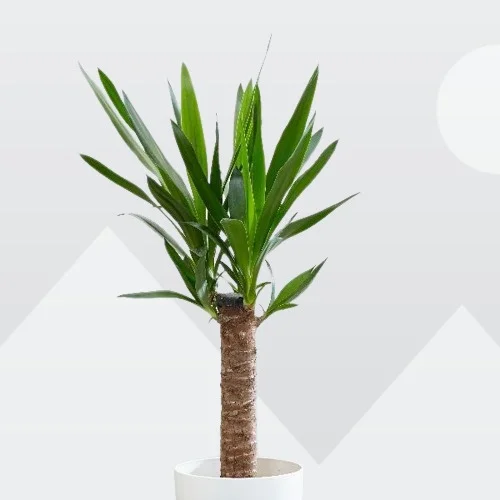
Spineless Yucca also called Blue-stem Yucca, Giant Yucca or Yucca Cane bears a crown of long, leathery, strap-like, spineless leaves and white bell-shaped flowers may appear on mature plants.
The Blue-stem Yucca requires a deep, well-drained container and a well-lit spot with some sunshine inorder to thrive. It can grow in a variety of soils and is drought-tolerant. It is reknown for being one of the hard to kill plants.
Yucca gigantea requires very bright light with 6-8 hours of direct sunshine, warmth of 16-280C, humidity of 50-55% and moderately moist, rich, well-drained succulents potting mix coupled with monthly feeding during the growing season.
Read more on how to grow and care for Spineless Yucca
19. Croton Plant (Codiaeum variegatum)
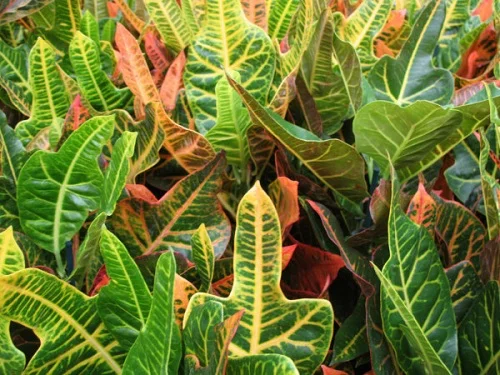
Croton Plants also called Joseph's Coat are popular large-leafed bold statement plants on account of their vivid foliage colors and varied leaf shapes which may be laurel-like, forked, long ribbons, lobed, twisted or curled making their identification dificult.
Crotons are tropical, evergreen shrubs which can grow to a height of about 9 feet and bear large, thick, leathery and shiny leaves. They are some of the best plants for the large spaces.
Codiaeum variegatum blossom in bright light with 4-6 hours of direct morning or late evening sunlight, warmth of 18-270C, humidity of 60-70% and consistently moist, fertile, well-drained potting soil coupled with regular feeding during the growing season.
Read more on how to grow and care for Croton Plants
20. Houseleeks (Sempervivum)
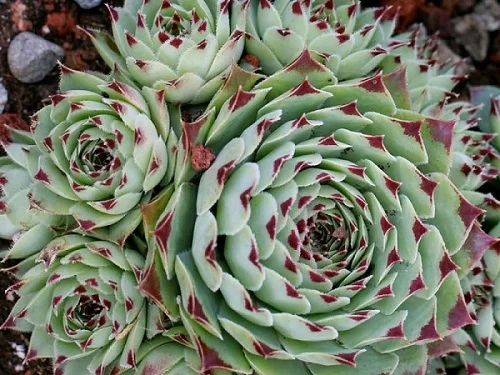
Houseleeks also called Liveforever or Hens and Chicks are popular, low-growing, succulent plants which form mats composed of tufted leaves in rosettes where each plant grows for several years before flowering afterwhich it dies, leaving many offsets (pups) for reproduction.
Sempervivums are compact plants reaching a height of 4 inches only. They are some of the best plants for the limited spaces in any place.
Sempervivum thrive in bright light with 4-6 hours of direct sunshine, warmth of 16-280C, humidity of 50-55% and moderately moist, fertile, well-drained succulents potting soil coupled with fortnightly feeding during the growing season.
Learn more on how to grow and care for Sempervivums
21. Aloe Plants
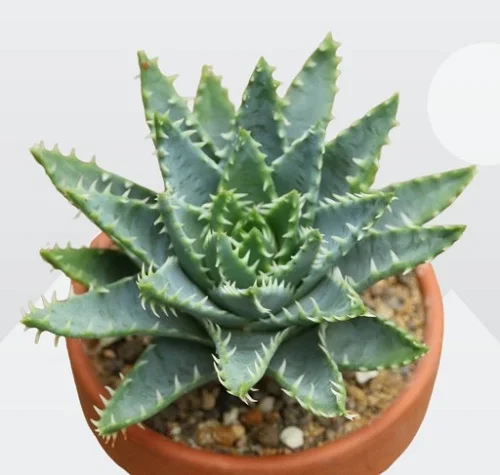
Aloe Plants are popular, succulent plants which come in all shapes and sizes. There are numerous species of Aloes but only a few are popular for home growing.
The popular Aloes include Aloe Vera (Aloe barbadensis), Aloe aristata (Lace Aloe), Aloe variegata (Partridge-breasted Aloe), Aloe jucunda, Aloe humilis (Hedgehog Aloe) and Aloe mitriformis among many others.Take a look at these 15 Aloe succulent plants ideal for growing in the home.
Aloes flourish in bright light with 6-8 hours of direct sunlight, warmth of 16-280C, humidity of 50-55% and moderately moist, rich, well-drained succulents potting mix coupled with monthly feeding in the growing season.
Learn more on how to grow and care for Aloe Plants
22. Echeveria Plants
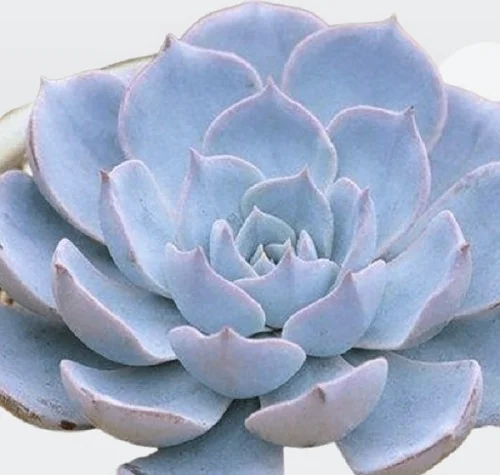
Echeveria Plants are low maintenance, easy to grow and propagate plants which form a rosette of short, beautiful and tightly packed leaves on short stems.
Some popular Echeveria Varieties include Echeveria harmsii (Plush Plant), Echeveria derenbergii (Painted Lady Echeveria), Echeveria desmetiana (Peacock Echeveria), Echeveria carnicolor and Echeveria amoena among others.
Echeverias propser in bright light with 4-6 hours of direct sunlight, warmth of 16-280C, humidity of 50-55% and moderately moist, well-drained succulents soil coupled with fortnightly feeding in the growing season.
Learn more on how to grow and care for Echeveria Plants
23. String of Nickels Plant (Dischidia nummularia)
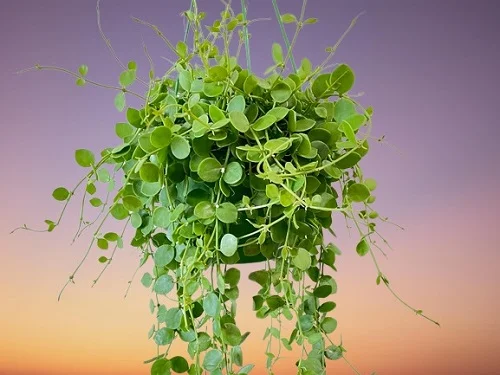
String of Nickels Plant also called Button Orchid is one of the popular hanging succulent plants forming a dense mass of greenish-yellow foliage comprising of round leaves and look like numerous coins, hence the common name.
Other popular Dischidia species for home growing are Dischidia ruscifolia (Million Hearts Plant) with numerous heart-shaped leaves on trailing stems, hence the common name and Dischidia ovata (Watermelon Dischidia) which bears oval shaped leaves with markings which resemble the rind of the watermelon fruit, hence the common name.
Dischidia nummularia flourishes in bright light with 4-6 hours of morning or afternoon sunshine, warmth of 18-260C, humidity of 50-55% and moderately moist, rich, well-drained succulents potting soil with two feedings during the growing season.
Read more on how to grow and care for String of Nickels Plant
24. Thread Agave (Agave filifera)
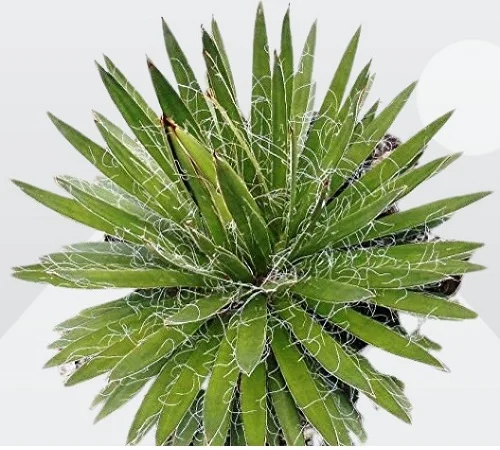
Thread Agave also called Thread-leaf Agave is an evergreen perennial plant and is one of the popular Agave plants grown indoors for its compact size which forms a beautiful, stemless rosette of long, blade-like, dark-green to a bronzish-green colored leaves.
The Thread-leaf Agave is a slow-growing, succulent plant which will thrive under direct sunshine and is one of the best succulent plants for a sunny spot like a sunny balcony, front porch among others.
Agave filifera requires bright light with 6-8 hours of direct sunshine, warmth of 21-320C, humidity of 50-55% and moderately moist, rich, well-drained succulents soil coupled with monthly feeding during the growing season in the first 2 years of growth.
25. Teddy Bear Vine (Cyanotis kewensis)

Teddy Bear Vine is a succulent vine which bears oval-shaped, hairy (velvet-like) leaves with purple undersides and and mauve colored, blue-violet or pinkish-purple flowers.
The Teddy Bear Vine is a slow growing plant whose stems beautifully cascade downwards which places it among the best plants for hanging baskets and limited spaces like an office desk, sunny balcony among others.
Cyanotis kewensis blossoms in bright, indirect light with 4-6 hours of morning sunshine, warmth of 15-270C, humidity of 50-55% and moderately moist, rich succulents mixes and regular feeding during the growing season.
Learn more on how to grow and care for Teddy Bear Vine
26. Sunglow Plant (Red Crassula)

Sunglow Plant or Red Crassula is one of the popular Crassula varieties whose stems are clothed with leathery triangular leaves which look like they are stacked on top of each other.
Red Crassula and its cousins Crassula cotyledonis (Crassula dubia), Crassula capitella 'Campfire' (Crassula Campfire) andCrassula picturata (Tiger Jade Crassula) are sun-loving plants whose foliage change color in very bright light.
Crassula coccinea flourishes in bright light with 4-6 hours of direct sunlight, warmth of 15-240C, humidity of 50-55% and moderately moist, fertile, well-drained succulents soil coupled with monthly feeding during the growing season.
Read more on how to grow and care for Sunglow Plant
27. String of Rubies Plant (Othonna capensis)
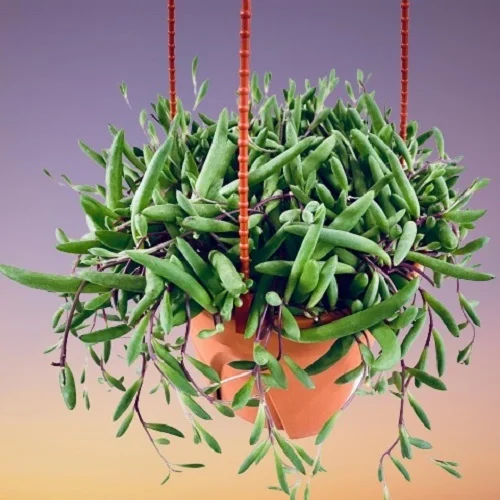
String of Rubies Plant also called String of Pickles, Little Pickles or Ruby Necklace is among the string of plants and bears reddish-purple stems and bean-shaped leaves which turn a bright ruby red when the plant is grown under bright sunshine.
The String of Pickles Plant grows as a trailer, with stems trailing which are spectacular when they cascade downwards beautifully in a hanging basket or on a pedestal.
Othonna capensis blossoms in very bright light with at least 6 hours of sunshine, warmth of 20-270C, humidity of 50-55% and moderately moist, rich, well-drained succulents soil coupled with two feedings during the growing season.
Learn more on how to grow and care for String of Rubies Plant
28. String of Buttons Plant (Crassula perforata)
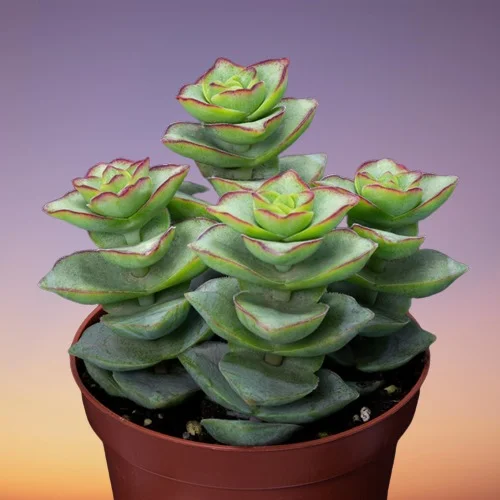
String of Buttons Plant is an easy-care, shrubby, succulent plant which bears triangle-shaped, gray-green leaves with a rosy pink hue along the edges in bright light.
The String of Buttons Plants and its relatives Crassula brevifolia (Crassula pearsonii) and rassula tomentosa (Woolly Crassula) are best watered by the 'soak and dry' method which requires a thorough soaking of the soil followed by a drying out of the soil before the next watering.
Crassula perforata prospers in bright light with 4-6 hours of direct sunlight, warmth of 15-260C, humidity of 50-55% and loose, well-drained succulents soil that is low in organic matter coupled with monthly feeding in the growing season.
Read more on how to grow and care for String of Buttons Plant
29. Dwarf Coconut Palm (Syagrus weddelliana)
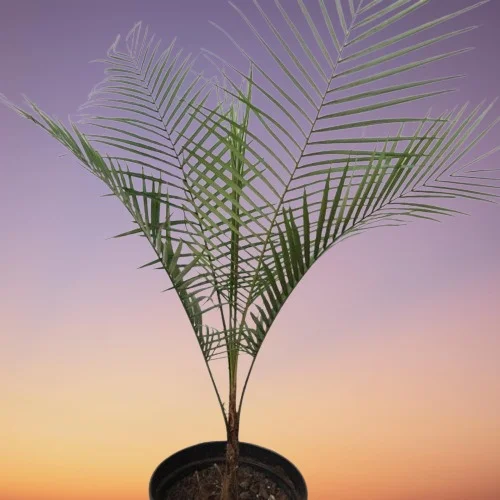
Dwarf Coconut Palm also called Weddell's Palm or Queen Palm is one of the popular palms and is closely related to Coconut Palm but it is much smaller and more tolerant to cold than the Coconut Palm.
Weddell's Palm is a single trunked palm with a small stature and produces edible fruits that resemble and taste like coconuts. However, it does not have the hardiness of most indoor palms and it is difficult to grow under room conditions.
Syagrus weddelliana blossoms in very bright light with at least 6-8 hours of direct sunshine, humidity of 60-70%, warmth of 15-250C and moist soil, fertile, free-draining potting soil coupled with monthly feeding during the growing season.
Learn more on how to grow and care for Dwarf Coconut Palm
30. Madagascar Jasmine
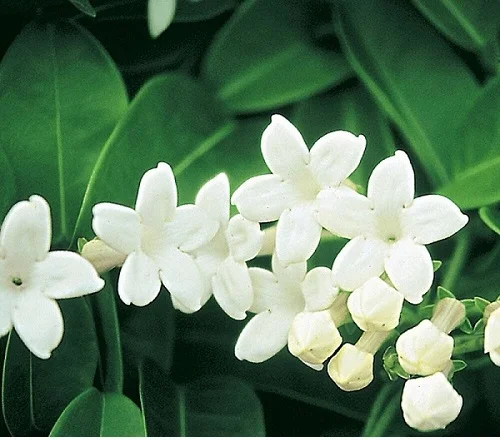
Madagascar Jasmine is a vigorously-growing, climbing, flowering plant with white, waxy, star-shaped, tubular, sweet-scented flowers which are borne on new growth in spring through fall.
Though called Jasmine, Madagascar Jasmine is not a Jasmine. It belongs to the family Apocynaceae (Dogbane family) along with Golden Trumpet (Allamanda cathartica). True Jasmines belong to the family Oleaceae (Olive family) an example being Pink Jasmine (Jasminum polyanthum).
Stephanotis floribunda flourishes in bright light with 4-6 hours of direct sunshine, warmth of 20-250C, humidity of 55-65% and consistently moist, rich, well-drained soil coupled with monthly feeding during the growing season.
Learn more on how to grow and care for Madagascar Jasmine
